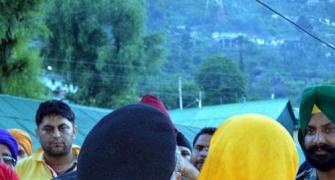 ‘How much rain fell on June 16 and 17 is NOT known because the area of Kedarnath is not covered by the Indian Meteorological Department,’ M Shashidhar Reddy, vice chairman of the National Disaster Management Authority tells Sheela Bhatt. Because of this, he says, the NDMA will not know “what exactly happened over there, in and around the Kedarnath temple.”
‘How much rain fell on June 16 and 17 is NOT known because the area of Kedarnath is not covered by the Indian Meteorological Department,’ M Shashidhar Reddy, vice chairman of the National Disaster Management Authority tells Sheela Bhatt. Because of this, he says, the NDMA will not know “what exactly happened over there, in and around the Kedarnath temple.”
In a state where more than three lakh tourists are present in the Himalayan mountain range during any tourist season, a state in which the Char Dham shrines are located, there is no equipment to forecast weather, there is no met department arrangement to measure the rains at Kedarnath or Badrinath, or facilities of any kind to observe the violent nature of rains in and around the glaciers behind the famous ancient temples.
All these years the government has never ever known which are the likely places the rains can strike. They never know anything, even about the intensity, says none else than M Shashidhar Reddy, vice chairman of the National Disaster Management Authority. Prime Minister Manmohan Singh is the chairman of the NDMA, an agency which is sorely lacking in action, drive and focus.
Talking exclusively to rediff.com, Reddy said how much rain fell on June 16 and 17 is NOT known because the area of Kedarnath is not covered by the Indian Meteorological Department. He said the NDMA will not know “what exactly happened over there, in and around the Kedarnath temple.”
What he means is the “scientific sequence of nature’s fury will never be known because there was no equipment put up there. What experts can now do is assess, guess and estimate the event.”
When rediff.com asked Reddy more about the humongous rainfall in which the death toll is expected to be in the thousands, he put it simply, “Nobody knew that this will be the kind of rainfall and this will be the kind of impact.”
Asked again -- “You are talking about the intensity of rains, right?” -- Reddy replied that he was not talking only about intensity. “Where is it going to rain today” should be known to authorities to carry out remedial measures.
"That makes all the difference," he said. In this case and in all the cases, the details of any kind -- to take action -- is not known to any authority in Uttarakhand so the helplessness of the state government is not a surprise -- and that no action was taken is also not a surprise.
After getting an idea of the horrific tragedy late in the day on June 19, Reddy called for a meeting of the officials of IMD (the agency that forecasts weather) and also the Central Water Commission (which forecasts and monitors floods).
Reddy said, “I wanted to know what was their present status of forecasting and observational capability. Apparently, they didn’t know how much it rained (in Uttarakhand on June 16-17) and where it rained. We don’t have the observation capacity (in those areas).”
When asked why, he said, “We don’t have it! We just don’t have it! It’s not there! All the areas are not covered anywhere in the world. In the June 19 meeting I asked them what was their plan for the next five years. I didn’t waste any time. I knew Uttarakhand is a warning that has come. The chief minister (Vijay Bahuguna) rightly said that with this kind of forecast (“very heavy rain”), what does he do? Could he build a bund behind the Kedarnath temple to stop it when he got the forecast on Sunday night? There was no precise warning even. They didn’t know, even, where it was going to happen. I am not finding fault with anybody. But, there were gaps in communicating the warning and how precise the warning has to be.”
After accepting that things have gone wrong, Reddy says, “I said in the high-level meeting that within 10 days I want a plan for world class observational and forecasting capabilities to cover the Char Dham yatra. We will follow it up.”
Image: Buildings destroyed during the floods are seen next to the Alaknanda river in Govindghat in the Himalayan state of Uttarakhand. Photograph: Reuters
Don't miss the full interview with M Shashidhar Reddy on Rediff.com tomorrow!









